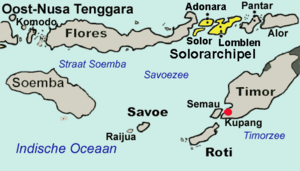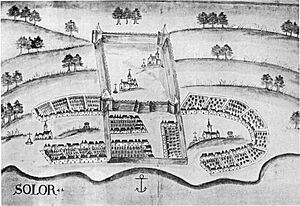Solor facts for kids
Solor is a small island in Indonesia. It is located near the eastern tip of Flores island. Solor is part of a group of islands called the Lesser Sunda Islands.
This island is known for its many volcanoes. Even though it's small, about 40 kilometers (25 miles) long and 6 kilometers (4 miles) wide, it has at least five volcanoes! The total area of Solor is about 226 square kilometers (87 square miles).
A small number of people live on Solor. They have been whaling (hunting whales) for hundreds of years. The people on Solor speak two main languages: Adonara and Lamaholot. In 2022, about 35,891 people lived on the island.
Island Administration
Solor Island is divided into three main areas called districts. These districts are:
- Solor Barat (West Solor)
- Solor Selatan (South Solor)
- Solor Timur (East Solor)
The whole island is managed by the East Flores Regency, which is like a local government area.
Island History
Solor Island has a long and interesting history, especially because of its location.
Early History
Around the 14th century, a powerful empire called Majapahit from Java was said to have taken control of Solor. The island was even mentioned in an old book called the Negarakertagama as belonging to Majapahit.
Later, in the 16th century, parts of Solor were influenced by the Sultanate of Ternate. This was a strong kingdom from another part of Indonesia. Solor was also a very important stop for ships trading sandalwood. Sandalwood was a valuable wood, and Solor offered a safe place for ships to anchor. This made Solor a key part of the trading routes in the area.
Colonial Times
In 1520, people from Portugal arrived and set up a trading post on Solor. This post was in a village called Lamakera. It was a useful stop for their ships traveling between the Spice Islands (Maluku) and Malacca.
In 1562, some priests from the Dominican Order built a fort on the island. It was first made of palm trunks, but it was burned down by Javanese Muslims. So, the priests rebuilt it using stronger materials. They also started teaching the local people about Christianity. By 1590, about 25,000 Portuguese and Christian people lived there.
However, the local people often fought back against the Portuguese and their religion. For example, in 1598–1599, the Portuguese needed 90 ships to stop an uprising on Solor.
Later, there were problems between the Portuguese traders and the priests. Many traders left Solor and moved to Larantuka on Flores island. In 1613, the Netherlands arrived and attacked. The priests gave up the fort and were also taken to Larantuka.
The Dutch took control of the fort, but they didn't find it as profitable as the Portuguese had. After some issues, they gave up Solor in 1636. The Portuguese returned, but the Dutch attacked again in 1646 and took the fort back. The Dutch left again in 1648, and the Dominican priests returned.
In 1851, the Portuguese governor tried to sell Solor and other islands to the Netherlands. This was done without permission from Portugal's government. The sale was finally agreed upon in 1859. Even though the Dutch officially owned Solor, they removed their small military force in 1869 because it wasn't making money.
During World War II, Solor was under Japanese control from 1942 to 1945. After the war, Indonesia gained its independence in 1949, and Solor became part of the new country.
Images for kids





